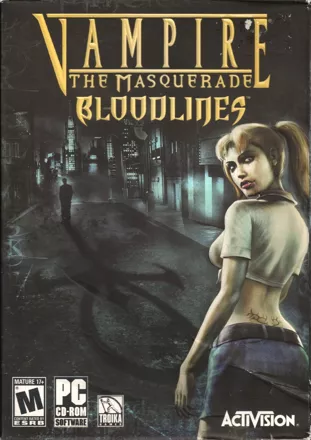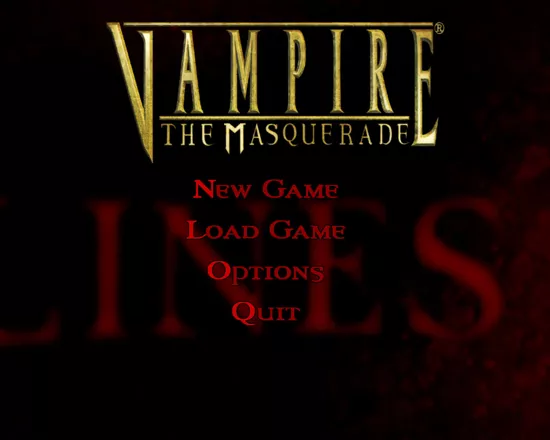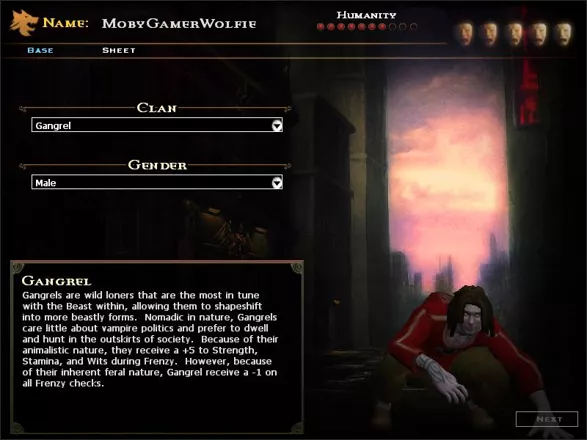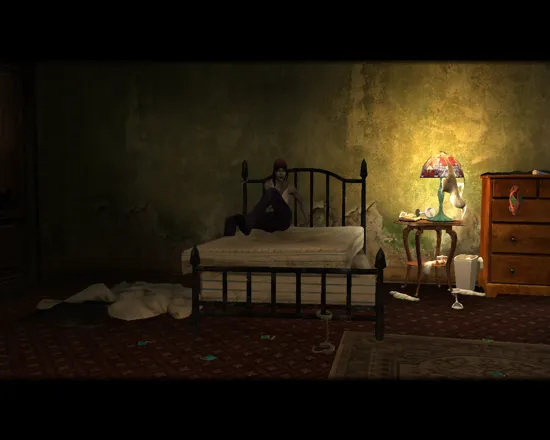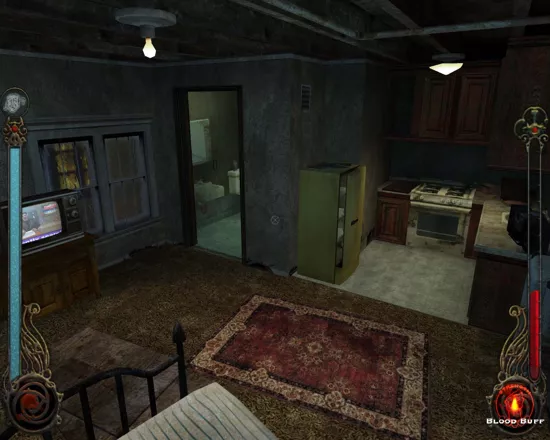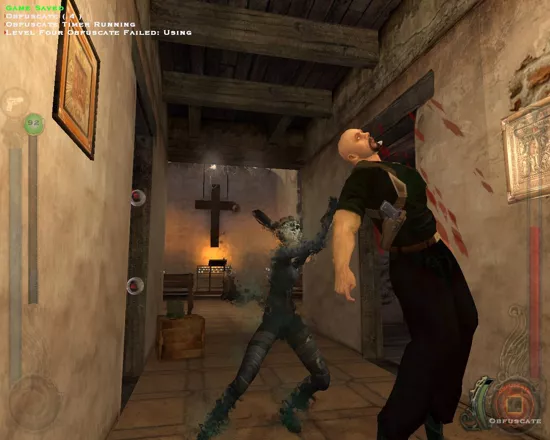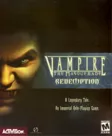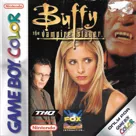Vampire: The Masquerade - Bloodlines
Description official descriptions
One morning, a seemingly ordinary inhabitant of modern-day Los Angeles wakes up and discovers that he (or she) is dead. Well, not exactly dead, but turned into a vampire - "sired", as the vampires themselves call it. Before the protagonist is able to reflect upon this new and unexpected form of existence, he is taken to a courtroom, where he gets acquainted with the Camarilla - an organization that preserves order among vampires. Apparently, the protagonist's sire turned him into a vampire without permission, so Prince LaCroix, the head of the Los Angeles Camarilla branch, decides to execute both. The hero's short vampire life would have come to an abrupt end if a mysterious person hadn't stepped in and convinced the Prince to spare it. The Prince takes responsibility for the protagonist from now on and decides to test his abilities, sending him to Santa Monica. Before long the new vampire becomes involved in a net of intrigues between powerful organizations and vampire clans and must choose his own place in this terrifying new world.
Vampire: The Masquerade - Bloodlines is based on the pen-and-paper RPG Vampire: The Masquerade. In the beginning, the player creates the protagonist, choosing between vampire clans, each with its own unique abilities and disciplines: Brujah vampires are suitable for melee fighting, Tremeres can cast spells, etc. In some cases the choice of a clan greatly changes subsequent gameplay: for example, Malkavians are insane and will therefore have completely different surreal dialogue choices; Nosferatu are so ugly that they can't pass for humans and will have to travel through underground paths throughout the game, etc.
The main character gains experience points only for completing quests, not for killing enemies. Many side quests are available during the course of the game. Experience points can be manually allocated to raise the protagonist's attributes, as well as improve various vampire feats. The player can make the main character stronger in combat, proficient in computer hacking or stealth, more powerful in vampire disciplines, more attractive, more intimidating, and so on.
Combat in the game is action-based. The protagonist can fight unarmed, use melee weapons and firearms, or employ special vampire abilities. Melee combat is viewed from the third-person perspective, but the view switches to first-person if the main character is using a gun. Blood is used to activate the vampire disciplines, working similarly to magic points in other games. It can be replenished by feeding on certain types of enemies.
The protagonist can also feed on innocent humans, though there are repercussions for that. The rules of the Masquerade forbid vampires to reveal their true nature to humans. Openly feeding on humans violates the Masquerade; five Masquerade violations lead to an instant Game Over. Feeding on humans with no witnesses present does not violate the Masquerade; however, killing an innocent human in the process alerts the authorities and causes the player character to lose some of his or her humanity. Losing too much humanity results in the protagonist becoming more and more susceptible to frenzy, eventually turning into an uncontrolled beast.
Many quests can be completed in different ways - brute force, stealth, diplomacy, intimidation, etc., depending on the preferred style of play and the main character's attributes. The player will also have to decide which faction the protagonist should side with throughout the game. Eventually, the player's choices will branch the storyline, leading it to one of the five possible endings.
Spellings
- 吸血鬼:避世之血族 - Chinese spelling (simplified)
Groups +
- 3D Engine: Source
- Gameplay feature: Character development - Skill distribution
- Gameplay feature: House ownership
- Gameplay feature: Multiple endings
- Green Pepper releases
- Middleware: Bink Video
- Physics Engine: Havok
- Protagonist: Female (option)
- Protagonist: Vampire
- Setting: City - Los Angeles
- Setting: Hotel
- Software Pyramide releases
- Sound engine: AIL/Miles Sound System
- Theme: Haunted house
- Theme: Vampires
- Vampire: The Masquerade licensees
- World of Darkness
Screenshots
Promos
Videos
Add Trailer or Gameplay Video +1 point
See any errors or missing info for this game?
You can submit a correction, contribute trivia, add to a game group, add a related site or alternate title.
Credits (Windows version)
316 People (275 developers, 41 thanks) · View all
| Creative Director | |
| Project Lead | |
| Lead Programmer | |
| Programmers | |
| Additional Programming | |
| Lead Scripter | |
| Scripters | |
| Additional Scripting | |
| Lead Animator | |
| Lead Character Modeler | |
| Animators | |
| [ full credits ] | |
Reviews
Critics
Average score: 81% (based on 48 ratings)
Players
Average score: 4.2 out of 5 (based on 162 ratings with 14 reviews)
The Good
Welcome to the city of fallen angels. The place of eternal darkness, where children of the night fight for survival. Welcome to the world where “good” doesn’t exist and “evil” is painted with thousands different shades of black and red. Embrace your newfound gift and enter the world of intrigue, treachery and every kind of sin you can think of. Welcome to the Masquerade.
Please excuse my overdramatic intro that looks like it belongs on the disc’s back cover. The reason I started the review in this way lies inside the game itself. Bloodlines is not an ordinary game, it belongs to the type of games that must be judged on different grounds and with different criteria than any other game of usual type. It must be approached differently because it transcends all the requirements gaming community sets to it. It goes beyond expectations and sets new standards, which won’t be broken, unless other game developers will change their mindset about what exactly constitutes a game as form of art. It may sound confusing, so I’ll try to explain it in detail. Read on.
Let’s discuss visuals of Bloodlines. What can be said here? Source engine? Bump mapping? Dynamic shadows? No. The first thing that catches my eye is the exceptional artistic quality of the locations you visit and the environments you see. I don’t give a damn about the pixel shader version the game uses. I couldn’t care less about the amount of polygons rendered in real-time by game’s engine. I don’t want to know whether it’s next-gen, cur-gen or past-gen. However I do care when I see a mysterious abandoned Chinese theatre where the old stone gargoyle had taken a residence or the sick sets of the underground porn studios or the luxurious interior of Prince LaCroix tower. Every location (with minor exception) of Bloodlines feels unique, original and helps to create an amazing sense of immediate presence.
The environments of the Bloodlines are not merely sets for the story to unfold in. They are also a continuation of characters’ portraits. It’s impossible to think about the sisters running the Asylum club without imagining a complete layout of the room they live in. This room is a manifestation of their mindsets, the fruitful addition to their storyline. The character designers and environmental designers must have been working really hard to achieve such an astounding level of collaboration.
As for the characters themselves I will simply say that Bloodlines features one of the most charismatic cast of characters ever to be encountered in a video game. The irony is that the undead characters of Bloodlines feel more real and human-like than many of living characters in other games. There are no good or bad characters in the game. Each one is a representation of certain ideas relevant to the rules of the vampiric society. And when those ideas clash you will have to decide what side is your character on and more importantly what ideals YOU personally uphold.
Really, I can go on and on praising the exceptional voice-work, perfect lip-sync and unparalleled range of face emotions Bloodlines characters are capable of. But truth is that you don’t think about any of that while meeting these characters, you simply like them, hate them, trust them or despise them. All in all, you feel a wide array of emotions that are usually applied to real people rather than to those at the other side of the screen.
As you see I deliberately missed out all the gameplay related issues. I did so not because I saved them for a Bad part, but because it’s really strange to think of Bloodlines while trying to establish how balanced RPG skills were or how responsive weapon controls were. It’s like trying to remember a picture frame for a painting you saw in a gallery. It feels secondary to the painting itself. And by no means is the frame bad, it’s just not that important when it comes to the magnificent artwork the painting itself represents.
The Bad
Much has been said about how bug-ridden this game is. Well, it’s true. The game was left unfinished, rushed by greedy publisher to the release date with only one or two bugs fixed. But is it Troika’s fault? Do you really believe that the game that received so much love and care from its creators would be simply abandoned and treated lightly when the time for QA came? I don’t think so. The same applies to the last quarter of the game which was surprisingly turned into a pure hack-and-slash non-fun, as if one of Troika’s executives had gone for a smoke, while a Diablo developer sneaked into a computer room and did his evil deeds.
If you allow me to carry a picture gallery analogy here as well I will ask you this. Would you think of Mona Lisa to be any less of an art if it was to be admired behind the iron bars? Or if you listened to Beethoven’s “Moonlight Sonata” in a crowded room on a lame stereo, would it lose its masterpiece status as well?
The Bottom Line
Don’t let people who answer yes to those questions fool you. True art lies not in perfection but in sacrifice, love and honesty multiplied by a considerable amount of talent. And I am safe to say that Bloodlines has plenty of this mixture in it.
Windows · by St. Martyne (3648) · 2007
Patch Me Once, Patch Me Twice, Patch Me Once Again.
The Good
I have a friend who keeps bugging me to play Werewolf: the Apoplectic, which I’m sure is a fine game, but whenever he describes the workings of the world, my eyes glaze over like I’m watching The League of Extraordinary Gentlemen again. It’s much better to jump into the game world and attempt to figure it out, which is what Vampire: the Masquerade—Bloodlines does. Vampire: the Masquerade has an equally complicated mythology with political factions and rivalries extending back to Cain, but once you’ve picked your vampire clan, all you need to know is that the head of the Camarilla was ready to kill you, but the “head” of the Anarchs called him on it, none of which matters right now because Sabbat forces are hunting you.
As mentioned above, players begin by selecting which type of vampire they are. Other than the hideous Nosferatu, whose blighted appearance confines them to the shadows and sewers, vampires of any clan can blend in with human society. Bloodlines has seven playable vampire clans (open to both genders). The biggest difference between clans, other than aesthetics and role-playing potential, involves core abilities and Disciplines. Disciplines are akin to spells and, this time around, their implementation makes sense for a CRPG. Some vampires can turn invisible, others can transform into wolves, while others still can cause an enemy’s blood to boil.
Bulking up the rest of Bloodlines’s formidable character sheet are physical, social, and mental attributes and talents, skills, and knowledges. These varied traits influence everything from a character’s appearance to their computer skills. Combined with the variety of vampire clans, Bloodlines has an amazingly deep character creation system. Nosferatu hackers, mad Malkavian mercenaries, Gangrel brawlers are all here.
Bloodlines is an RPG and, while technically a sequel to 2000’s Redemption, it plays completely differently. The original game resembled a standard dungeon crawler, where the player led a coterie (party) through a series of vampire-laden chantries (dungeons). Bloodlines, on the other hand, resembles Deus Ex. Gone are coteries; in their place is a single character game played from either a first or third-person perspective.
Instead of sprawling continents and centuries like its predecessor, the world of Bloodlines is confined to four huge maps spread around modern day Los Angeles. Players begin in Santa Monica, and travel to Downtown LA, Hollywood, and Chinatown on a series of missions. I doubt Hollywood has a zombie problem, but overall the areas have a realistic feel. Rather than having NPCs standing about, pedestrians bustle, homeless people gather around burning barrels, young toughs wait for cops to pass by before tagging buildings, and people enter clubs to drink and dance.
Bloodlines has a solid set of story-based missions, but some of the most fun comes from stumbling onto side quests. What is the connection between a tattoo artist and a prosthetic limb designer? Does a walk-in clinic hold a vial of Werewolf blood? Sure the main quests with its serial killer, ancient sarcophagus, and Asian vampires are interesting, but so are the ones involving escalating levels of brinkmanship between two retired hitmen, a one-armed swordswoman and her quest for vengeance, and a Cemetery Man who’s caught between his duty and his urges.
An extra bonus to completing Bloodlines’s quests is seeing how their resolution plays out. Everything your character does impacts the game. Good acts (as good as vampires get) restore your character’s Humanity, keeping the vampire’s bestial nature at bay. Throughout the game, you can act on behalf of different factions, which influences the game’s events, most heavily during the ending sequence.
The Bad
Bloodlines is a good RPG. If it weren’t buggy to the point of instability, it would be a great game. Superb, even. The first problem I had occurred during the opening animation, or lack of animation. Characters that should have moved around on the screen did so without the usual running or walking, instead they moved around like Colorform characters.
Shortly after that I entered into combat. I didn’t mention combat above. Bloodlines has tons of combat. Hordes of combat. Plenty of weapons. Piles of cool offensive spells. But severe framerate problems, loose controls, and an annoying feature where, when reloading a game saved during combat, your character’s gun empties its clip, made combat frustrating. This may sound a bit harsh, but I am astonished at how clunky combat is considering how important combat is to the game. Shocked even, to discover that we’re talking about the Source engine here.
Other interesting quirks I ran into involved event triggers which failed to trigger. Hours after I rescued her, I saw a cutscene of a girl being kidnapped. I fumbled with stuck doors which were mission critical. There was an epic bar fight in which the patrons took no notice. Probably my favorite element of badness involves the Quick Save. Press F9 and in as little as one minute, your game will be saved. And for a game with long saving times, the loading times don’t disappoint either.
Apparently some of my problems were caused by my having the wrong sort of video card. The NVIDIA slogan, “The Way It's Meant To Be Played,” should be accompanied with an image a boot stamping on a human face—for this game. I also patched this game several times (and edited in Python to fix one bug).
The Bottom Line
For all the annoyances that come with it, Bloodlines is still a great game and one of the better CRPGs to come along. Only one of the problems I ran into was a game stopper. Bloodlines has a satisfying character creation system and, having tested a few characters and checked a few FAQs, Bloodlines has a very high replay value.
The biggest drawback I see to Bloodlines is its over emphasis on combat. While players have a free hand in creating their characters, I’m pretty sure that players who don’t invest in combat skills will get creamed. This is a shame for a game that has so many other options more suited towards actual role playing.
Windows · by Terrence Bosky (5397) · 2006
An extremely intelligent example of "postmodern entertainment"
The Good
Troika's "Vampire: Bloodlines" is a wonderful game, set in a present day city environment in Los Angeles. Within this quite realistically presented city exists a vast sub-culture of Vampires and all sorts of other, super-natural creatures entangled in a complex society of their own. The game's focus lies heavily on describing this vampiric society and culture. However, since Vampires have hardly more regard for humans than humans have for cattle, the two depicted societies ("real", "human" L.A. and "vampiric" L.A.) hardly ever mix, except when a "new" human gets in some way or another introduced into said vampiric sub-culture, which is exactly what happens to the player right at the beginning of the game.
With its approach of assuming two entirely different cultures sharing one physical space, this game succeeds splendidly at simulating the player's "newborn" feel - in a world he/she knows quite well ("Vampire"s L.A. is, after all, the L.A. from the movies) an alternate culture exists and has always existed - behind back doors, in shady bars or in secluded towers. Since this is the only culture the player is really allowed to deal with during the game, he/she will quickly get accustomed to it, accepting it as the actual "reality" - which quickly renders the regular "human" reality he/she knows of to appear less real than the fictitious one.
This is truly an elegant way to begin a game: "Vampire: Bloodlines" starts out with a world the player knows, only to have him/her then concentrate more and more on a world he/she doesn't know (yet) - a world entirely new. Apart from this intriguing starting point there are many things which are great about this game. This review shall now separately address technical, gameplay and content aspects.
- Technical
"Vampire"s graphics are impressive, probably not so much in themselves but because of the how and why of their usage. Graphics in "Vampire: Bloodlines" always serve one or more of three distinct purposes: their design reflects the personalities of people (e.g. Jeannette's room, the Nosferatu city, LaCroix' tower etc.), they build up a distinct genre background complete with an appropriate atmosphere (hotel, graveyard, Giovanni mansion etc.) and they are used as elements of contrast and conflict within the game world (the player's shabby apartment vs. LaCroix' salon, the Anarchs' "punk-bar" vs. the Tremere's hide-out etc.). This form of contrast is additionally used to violently shock the player as he/she penetrates harmlessly looking suburban homes just to find them filled with unbelievable horrors - a clever device considering the Vampires' own reliance on the "Masquerade", i.e. on hiding away from human perception. Moreover, all places in this game are superior in design and colouring. Together with the extremely detailed facial expression animations of characters they brilliantly succeed in bringing the game's world to life and tying the game's widely differing elements together.
"Vampire"s musical score goes hand in hand with this. Just as the actual game, it covers a wide variety of genre terrain (ambient, ethnic, orchestral, trip-hop, punk, industrial, gothic...) while still remaining "in tone" with the game's main conception of exploring an alien society.
Voice acting can only be described as excellent. It is not only very professionally executed, but serves the same three purposes attributed to graphics: characterization, setting a genre and depicting contrast. On the streets, people talk Al Pacino-like L.A. slang, LaCroix talks elaborately high-brow, Jack hilariously low-brow...these are not only voices meant to spare the player the abominable task of reading, they are actually well-acted and always "in character".
- Gameplay
As noted in other reviews, "Vampire: Bloodlines" is a real-time based 3D-Action-RPG similar to classics such as "System Shock 2" or "Deus Ex". It employs a number of RPG features such as different player characters, stats, experience points and numerous side-quests while offering the player a choice between shooting and sneaking during combat.
However, although this game boasts quite a few exhilarating fights (especially during the endgame), its focus lies clearly elsewhere. With its many intricate multiple-choice dialogues and its vast amount of side-quests designed to lead the player around its various, colourful settings, "Vampire: Bloodlines" is really a game of "social exploration" - its main aim is rather to find out about vampiric society than to follow its main plot, which is but a large "MacGuffin"-hunt anyway, largely created to make said society's innate conflicts escalate.
Moreover, the player is offered quite a lot of choices during gameplay. Interestingly though, these are not only limited to "moral choices" defining how the story will proceed (although these are present, too): in this game, a different playing style may unlock whole new aspects of gameplay including new characters, dialogue and quests. If one plays the game with a Nosferatu or a Malkavian character the entire game will appear to be completely different, however, even with one of the more "usual" characters gameplay may adapt drastically to a players choice of approach.
One example: when one chooses the talkative route to tackle the Giovanni mansion, one will get to know a number of characters to exercise one's social talents upon, one will be entangled in a very "Godfather"-like mafia intrigue game with the opportunity to make NPCs turn against each other. If, however, the player chooses to kindly inform the mansion's front door guard that he/she intends to kill everybody within the house, the game's transmitted genre will drastically change: the player will now have to face a plain white marble villa jam-packed with approx. 500 black-suited, heavily armed baddies all waiting to be killed - and these are simply not there if one picks the peaceful approach! Female NPCs which are of vital importance during the peaceful version of this scene will simply be omitted (probably fled through the windows) and the whole tone will be that of a John Woo action flick (seen "A Better Tomorrow II."?).
Thus, in "Vampire: Bloodlines" the player's choice may not only effect the outcome of a set situation like for instance in "Deus Ex", it may at times also decide whether certain plot elements or NPCs will "start to exist" in the first place. This is an interesting way to assign more meaning to the player: instead of always making NPCs boast at the player character's importance to make the player feel better, "Vampire: Bloodlines" does not only allow the player to cut through whole sections in whatever way he/she wishes - it even adapts itself to these wishes at times.
- Content
As already hinted at, this has to be one of the most postmodern games ever created - for a number of reasons. Due to its heavy reliance on quests rather than on a linear plot it's structure appears to be largely episodic. It's dialogue is not only extremely well written, but it's continuously tongue-in cheek, witty and ironic, even when dealing with the most brutal events and outcomes. Most important, however, is this game's playful approach to genre, "art culture" and to notions of reality vs. different kinds of fantasy.
"Vampire: Bloodlines" is highly infested with all sorts of allusions to all kinds of literature, movies, cultural phenomena and even present-day politics. These are not only extremely numerous - in fact, they're all over the place - but they also seamlessly range from their "lowest" (i.e. porn, splatter, snuff films etc.) to their "highest" respective forms (Scorsese, Hitchcock, Shakespeare etc.). Almost every genre is hinted at and played with in "Vampire: Bloodlines", shifting from witty screwball comedy to hentai in a split-second.
Most fun, however, is naturally had with the horror genre. Allusions, places and story elements include the classic "haunted hotel" setting, Cronenbergian visions of mutilation and "Body Horror", Hieronymus Bosch's apocalyptic vistas, George Romero's zombie slaughter-fests, Murnau's early German expressionism, mad scientists, serial killers, Victorian mad-houses, etc. etc. - it would be impossible to mention even a fracture of this department.
"Vampire: Bloodlines" gets successfully away with all this genre switching just because it fully dedicates itself to its own playful postmodernism - this game really declares constant, more or less radical changes of place, dialogue, style and atmosphere to be its main point of "unity".
However, apart from being playful, witty and ironic while dealing with its own, "fractured" design "Vampire: Bloodlines" effectively keeps itself from becoming a mere "guessing game" of popular/high culture simply because everything is executed so extremely well. The "horror house", for instance, is quite an obvious allusion to a whole set of movies - and yet it's still a frightfully effective horror level because of its intelligent build-up and some positively spooky graphics and eerie sounds. That's where this game really strikes a fine balance: while everything is presented quite ironically and with a lot of tongue-in-cheek humour, it's places are still seriously threatening, it's NPCs are still seriously interesting characters and it's plot-lines are still seriously engaging. Combined with all the allusions to various examples of the horror genre, it impressively shows that even the most corny and well known mechanics (flying books, bursting doors, howling wolves etc.) continue to be frightful if they're well executed - and, as already mentioned, this game features a masterful execution across the board.
Last but not least: this game almost academically addresses the elusive relationship between reality and fiction/fantasy - and in this context its postmodern means of quotation and allusion actually make real sense.
The motif of the Vampire already sets this game's main topic: since the late Victorian times of "Dracula", Vampires have always been regarded as an embodiment of exciting (and erotic) fantasy lurking behind an outwardly "normal" appearance. This employed contrast between a respectable, more or less reality-based "outside" and a fictitious "inside" which may be both frightening and fascinating at the same time has already been hinted at in this review and is used throughout the whole game.
!!! WARNING !!! SEVERAL SPOILERS AHEAD !!!
Even the game's title implies the notion of masquerade, i.e. the veiling of one's true nature, and thus a dissent between "inside" and "outside". As already mentioned, the game begins with a reality shift in which a natural "outside" reality is more or less replaced by a super-natural "inside" one which also physically exists "inside": behind locked doors or in secluded apartments. This "vampiric" reality is, however, further fractured in itself and contains several additional divisions between "inside" and "outside": the different clans hide away from each other, different political fractions live in significantly different locations and outwardly "normal" NPCs may reveal their true, "monstrous" nature any minute.
The whole game, its plot as well as its settings, is filled with notions the treachery and unreliability of what's supposedly "real". Both the Camarilla and Prince LaCroix hide their true motivations. The Kuei-jin are actually shape-shifters with a more than elusive "outside", as is the game's final enemy. Jeannette has a split personality including a respectable, controllable "outside" part as well as an outlandish, exciting, but menacingly crazy "inside" part (both of which are in constant conflict and very hard to reconcile). A strip dancer turns out to be a Vampire killer, a church hosts a gothic club, a gothic club hosts the mafia, a snuff-film containing "real" killings is made with "unreal" (or "surreal") monsters which are hopping around various movie-sets...the list of "inside"-"outside" contrasts and uncertain realities to be found in "Vampire: Bloodlines" is just too long to be coincidental. In the end (at least in the ending I got) the "inside" of the main plot's "outside" sarcophagus everyone is rambling about (though its opening might actually end all life - again, the fascinating goes hand in hand with the threatening) is not revealed: in fact, it may be rather the players' and the various NPCs' shady fantasies than anything "real" which fills the sarcophagus' "inside".
By now it can easily be seen that "Vampire: Bloodlines" does in fact not only challenge the player's perception of "reality", but also his/her perception of the nature of the "fictitious", of "fantasy" - which can be both exciting and dangerous, even (or especially) at the same time. This is certainly one reason why this game contains so many allusions to both present-day reality and all kinds of different fantasies (i.e. all kinds of novels, movies etc.) from all imaginable "quality levels": it offers the player a kaleidoscope of our own world's immense chaos of varying and uncertain realities and of the often enough dubious nature of our fantasies (which aren't any less chaotic).
The city of Los Angeles is a somewhat final expression of that notion: it's just as much a real city as it is a "dream factory", and as a "dream factory" it does not only offer a vent for our pleasant, glossy "Hollywood" fantasies, but for all the uncomfortable and dark ones, too.
The Bad
Many minor negative issues have already been addressed in other reviews, so there is no need to address them again. It has to be noted, though, that most of the bug and loading-time related problems have been largely eliminated by now due to the numerous existing fan-patches and the more advanced hardware which is accessible today (reminds one of Origin-days, doesn't it?).
However, one can apply the same piece of criticism to "Vampire: Bloodlines" which one can apply to most postmodern art in general: for some people, it may well be too witty, too ironic, too varying in its atmospheres and places and, well, probably a bit too cold. "Vampire: Bloodlines" is often enough quite the contrary of a heart-quenching experience. No sir, in a game where one can play basketball with a severed human head and slap enemies silly with a severed human arm, emotional qualities are indeed bound to suffer.
All in all, "Vampire: Bloodlines" is extremely well-done, literally glows with style and intellectuality - and is probably more aimed at one's head than at one's heart.
The Bottom Line
Apart from some minor negative points, "Vampire: Bloodlines" is a great game in all respects. It features stellar production values across the board, it's gameplay is innovative and fresh and it's content is extremely witty, intelligent, "up-to-date" and - in the end - even thought-provoking.
It is a must-play for everyone who is interested in a 3D-RPG which is in the best possible way modern, moreover, it's simply a treat for postmodern blokes trying to find out just how many horror movies they've seen, as well as for anyone interested to find out more about the relationship between respectable "outside" realities and the ambiguous aspects of (wanted? feared?) "inside" fantasies. In this respect, it is not only a worthy contribution to the motif of the Vampire but also, in the original meaning of the world, perverse (lat. "perversio": a twist, a reversal).
Windows · by worldwideweird (29) · 2008
Discussion
| Subject | By | Date |
|---|---|---|
| Sequel? | Scott Monster (986) | Sep 7, 2015 |
| Can't Stop playing this game! | Scott Monster (986) | Jan 4, 2009 |
| What kind of bloodsucker do you think you are? | Slug Camargo (583) | Oct 26, 2008 |
| Odd Vampire at Cafe? | Indra was here (20756) | Jul 31, 2007 |
| Werewolf part | Donatello (466) | Jun 20, 2007 |
Trivia
Bugs and patches
Troika did not learn its lesson from The Temple of Elemental Evil (see the trivia section). Once again, serious problems and bugs have been left unattended for too long, until a fan, dan_upright, jumped in with his own fixes in an unofficial patch. The releases of unofficial patches were then continued by Werner Spahl until most bugs were fixed. In the final two weeks of Troika's existence, several employees volunteered to help finish with patch 1.2.
Because of the "beta" state this game was left in even after patch 1.2. Several unofficial patches have been released for Bloodlines. There were two lines of fanpatches, the original "unofficial" patch by Wesp which does not only fix bugs, but also adds adds new weapons, disciplines, occult items, quest items, and action sequences, based on content left over from development hidden in the installed game files.
Another fanpatch, the "true patch" was started by Acrimonious and Tessera, previously known for creating nude patches for various games, on the Tessmage.com forums with assistance by several forum members. It is intended to be a true patch to the official 1.2 version, only fixing bugs found in the original game or the official 1.2 patch. There was a huge flamewar between the Tessera and Wesp, eventually leading into Tessera shutting down his website.
Character creation
The game was supposed to have a fourth character creation mode which would enable you to add a history to your character rather than setting the various attributes by hand. It's still in the final version of the game although it's disabled by default. The choice of history has a large impact on the game, as it basically gives players a bonus effect in certain areas and a negative effect in others. Visit the "Tips & Tricks" section where the actual unlocking process is explained.
Development
Bloodlines is the second game to use Valve's Source engine, after Half-Life 2. Valve did not want another game to display the new source engine prior to Half-Life 2, so when Bloodlines went gold on October 4, 2004, Troika worked on a patch that was integrated into the duplication master prior to shipping on November 16th. Work on the multiplayer was halted for some time during development, with the intention of picking it up later, which is what happened. However, the multiplayer gameplay never really came together and it was dropped a couple of months before shipping.
German version
In the German version, the decapitation during the intro was removed. The rest of the game is completely uncut.
Misc
- In the beginning of the game, when you need to get the astrolite, look around the house on the beach. There is a game paused on the TV that shows one of the large monsters from in the sewers later on in the game along with a vampire who is re-loading an Anaconda.
- When you use a pass card to open a hatch that leads to Nosferatu hide-out (after the long sewer dungeon), take a close look at the computer. On the right side, there is a message that looks very similar to the common Windows' "Fatal Error" screens. It says the following:
SLOW
A fatal error has occurred. You should be panicking now. Your system will now explode. It is now safe to go to your happy place. Press any key to help others learn to read. Press Ctrl+Ctrl+Ctrl to donate money to me, you know the computers will soon take over, why fight it? * If you visit Mercurio just before the final showdown you will learn what exactly Camarilla (one of the factions in the game) thinks of Troika Games' leading developers. * After you find the man beheaded in the building across the Last Round bar you might want to take his head and try to score in a nearby basketball ring. If you do so the applause will be heard. * The song that briefly plays near the end of the quest "The Ghost Haunts at Midnight" at the Ocean House Hotel is "Pilots" by Goldfrapp from their debut album Felt Mountain.
References
- There are a number of references to find throughout the game; many to movies. One is the book "the art of the quickdraw by Ned Nederlander". Ned Nederlander is the character played by Martin Short in the movie The Three Amigos, who is said to be the fastest draw in the world.
- One reference in the game is when you talk to the food critic in Hollywood. If you are Malkavian, you can convince him that he is eating maggots. This is a reference to the movie The Lost Boys, in which a group of teenage vampires convinces a man that the rice he is eating is actually maggots. When you speak to the food critic and convince him, there is even a line of dialogue saying how that "happened in a movie once".
- In Hollywood, look at the commercial above Isaac Abram's jewelry store. It says: "Play Troika Games!". Troika is the developer of this game.
- During your computer-hacking side-quest (received from the computer geek at Nosferatu hideout), you'll come across the password Gil Bates. Gil Bates is one of the central characters of Arcanum, another RPG by Troika. On the other side, Gil Bates himself is a parody on... well, you figure out that one.
- The NPC Romero, whom you meet at the cemetery in Hollywood, is named after George A. Romero, the father of the Zombie movie genre. Why? You'll have to accept Romero's quest in order to find out.
- Another NPC, the Nosferatu hacker Mitnick, is named after Kevin Mitnick who in the early to mid 90s was one of the most notorious and wanted hackers in the US.
- The news broadcast that can be heard when switching on the TV in the the player's haven contains a reference to famous horror author H. P. Lovecraft. The anchorman speaks of a squid-like creature found at the shore of Providence, Rhode Island. This is an obvious nod to Lovecraft's birthplace and his Cthulhu myth.
- Some time later in the game you might learn from the TV a shocking news of EU collapse. Quite interesting is that the end of EU was one of the reasons behind the nuclear war in Fallout, game developed by Black Isle, the former employees of which constituted the major part of Troika Games.
- If you hack in to one of the computers in the Internet Cafe, you'll find a reference to the "Chocula" clan. For those that don't know, "Count Chocula" was a cartoon vampire spokesman for Chocolate cereal.
- In most of the dance bars, you'll see a dance icon. The symbol is pointing gesture made famous by John Travolta in the movie Saturday Night Fever.
- This game is highly infested with all sorts of allusions to all kinds of movies. Clan Nosferatu's network system "Schrecknet", for instance, hints to German actor Max Schreck who played the original Nosferatu in the ground breaking German silent movie Nosferatu - Eine Symphonie des Grauens (1922) by Friedrich Wilhelm Murnau . This is even more interesting because Clan Nosferatu's whole look is heavily influenced by Max Schreck's outfit. Could he have been the first Nosferatu? Check out Merhige's Shadow of the Vampire (2000) and judge for yourself...
- An easier one of many literary half-quotes to be found in Vampire: Bloodlines: The quest received right at the game's beginning "Wherefore art thou Mercurio" is obviously derived from the more famous original "O Romeo, Romeo! wherefore art thou Romeo?" (Shakespeare's Romeo and Juliet, Act II., scene 2). Note that one of Romeo and Juliet's main characters is appropriately named Mercutio.
- Look for this pop culture reference during Phat Larry's side quest. In the parking garage, you overhear two thugs talking. "Do you like John Woo? Bullet in the head, son!" The other thug responds, "I don't get it." John Woo, is arguably Hong Kong's most famous director. With films such as, The Killer, Hard-Boiled, and Bullet in the Head.
- In the arcade over at the beach, there are three games: Pitfall, River Raid, and Call of Duty. They were all released by
Activision as is this game. In fact, an emulator was in the works so you could play River Raid and Pitfall, but it was eventually dropped due to time constraints
Soundtrack
A release exclusive to Best Buy included the following soundtrack: 1. Bloodlines - Ministry - Come Alive - Daniel Ash - Cain - Tiamat - Swamped - Lacuna Coil - Isolated - Chiasm - Needle's Eye - Die My Darling - Pound - Aerial2012 - Lecher Bitch - Genitorturers - Smaller God - Darling Violetta - Swamped (Video) - Lacuna Coil
Awards
- 4Players
- 2004 – Best PC Role-Playing Game of the Year
- 2004 – Best PC Story of the Year
- Computer Gaming World
- March 2005 (Issue #249) – RPG of the Year
- GameSpy
- 2004 – Best Level of the Year (PC) (for the Ocean House Hotel)
Information also contributed by Apogee IV, Boris Stovich, Little Yoda, MasterMegid, Scott Monster, SimonG, St. Martyne, tata_lu_stefan_cel_mare, Terrence Bosky, Unicorn Lynx, worldwideweird
Analytics
Upgrade to MobyPro to view research rankings!
Related Sites +
-
Bloodlines
Official website -
The Bloodlines Wikipedia article
A very detailed article with in-depth information about the game. -
UHS File for Bloodlines
Question and answer type strategy guide. Viewable online or can be downloaded for use with the UHS software. -
Unofficial patch at The Patches Scrolls
Here you can get the latest unofficial Bloodlines Patch. Highly recommended! It fixes a lot of problems and offers a far better experience.
Identifiers +
Contribute
Are you familiar with this game? Help document and preserve this entry in video game history! If your contribution is approved, you will earn points and be credited as a contributor.
Contributors to this Entry
Game added by HandofShadow.
Additional contributors: Unicorn Lynx, Jeanne, Sciere, SGruber, Patrick Bregger, Infernos, BlaringCoder.
Game added November 27, 2004. Last modified February 13, 2024.
